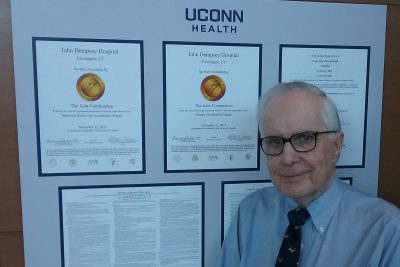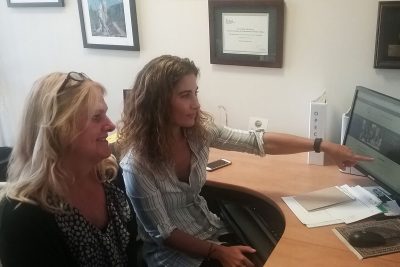
On the third Tuesday of the month, Frank Greaney of Southington has a standing appointment at UConn Health’s Outpatient Pavilion.
He is a patient, but for this hour his role is patient representative—a voice at the table where a crucial component of UConn HealthONE is taking shape.
Greaney, a founding member of the UConn John Dempsey Hospital Patient and Family Advocacy Council (PFAC), also serves on the Online Patient Engagement Committee (OPEC). This group was established earlier this year by the staff tasked with building the patient portal for HealthONE, the high-tech electronic medical record (EMR) system UConn Health is unveiling next spring.
“The OPEC members actually welcome and invite our comments,” says Greaney, a retired health care executive who, between his life’s work and his own medical challenges, has set foot in many of the country’s most successful health care facilities. “I’m impressed by the diligence of the OPEC participants and their diligent work. Everything they do has an effect on the project.”
The HealthONE patient portal will enable patients to complete such tasks as arranging appointments, requesting prescription refills, and accessing test results, all by way of a secure online account.
“My test results will be available quickly,” Greaney says. “I can run a table on my lab results for the last six months, a year, a year and a half. I can look at a summary from the last visit. I can arrange, change, or cancel appointments, and indicate the reason for my visit. It’s really going to do a lot.”
Greaney would know. He is one of two patient representatives recruited to join OPEC. Both are familiar with Epic, which provides the EMR software platform, and MyChart, which is Epic’s patient portal, from their experience as patients at other hospitals. UConn Health chose Epic as the vendor for its EMR system and branded it as UConn HealthONE.
“There’s a discipline to electronic medical records that does not exist outside the world of electronic medical records,” Greaney says. “This improves internal quality and empowers us as patients to have an active role in our care. You have your own records now. You have your own information. It’s empowering.”
OPEC members are a diverse group representing perspectives from throughout UConn Health, from patient care to billing to compliance to information technology.
With input from the patient representatives, they come up with recommendations on how to optimize the portal and make HealthONE a valuable tool for patients.

“We want to create a product that our patients are happy with,” says Bonnie Johnson, a HealthONE analyst who facilitates the OPEC meetings. “We want to make sure we not only are meeting statewide regulations, but also the expectations of our patients, because we also want to stay relevant in the marketplace.”
Topics OPEC has weighed in on so far include recommendations on screen design, support mechanisms, and timing of the portal’s introduction to patients.
“We are most pleased to have patient advocates who have joined our OPEC committee to provide a consumer perspective,” says HealthONE Ambulatory Director Kathy Noel. “The widespread perspectives shared by many across the organization allow us to discuss and determine our course through the eyes of different stakeholders.”
But that doesn’t mean the patient representatives have the final say.
“We’re here to provide perspectives, to give our opinions if asked, with the understanding that, ‘Anything we say, you are free to completely ignore,’” Greaney says. “The internal stakeholders are at the table as this program unfolds. This project requires a staggering amount of coordination. The people in this group are at the top of their respective games. And Bonnie seeks buy-in from everyone who makes this hospital work at the granular level.”
Dr. Rebecca Andrews, primary care physician and OPEC chair, says ultimately HealthONE will offer patients much more than a new and improved accessible portal for messaging.
“The hope is to engage the patient through inpatient admissions or after outpatient visits and in between episodes of care,” Andrews says. “If we develop a robust population health team, it would also be a means to reach out for testing, guideline-driven care, or needed visits to a whole group of patients at once.”
And that can only help patients, Greaney says.
“I think this is the highest-quality, safest hospital in the state,” he says. “HealthONE is a true portal, one that will open a lot of doors for the community.”